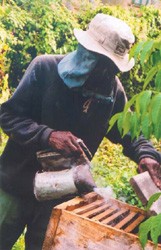
Honey has traditionally been an important part of the Haitian diet. However, over time it became harder to obtain honey. The political destabilization of 1986 eliminated public and private institutions involved in production and training of beekeeping skills in Haiti. The industry, comprised of individual beekeepers, also suffered a blight which eliminated more than three-quarters of the bee population. Honey production in Haiti was almost nonexistent. As a result, honey became more expensive and had to be imported. Producers and consumers alike helplessly let the industry and its assets dwindle.
Initiative
USAID’s Farmer to Farmer Program, administered by Partners of the Americas, addressed this problem by conducting seminars and field visits to teach basic bee maintenance, bee nutrition in the dry season when no flowers are available, and how to combat disease. Haitian beekeepers struggled with basic issues of bee management and prior to Farmer to Farmer volunteer assistance, many beekeepers weren’t using hives at all, but rather tending to the bees wherever they happened to build their nest.
Farmer to Farmer volunteers demonstrated and taught hive construction to Haitian beekeepers, including size of the main structure, lids, and proper wood sources. The volunteer also fostered the development of stronger associations and networks among beekeepers. By working together in organized groups, the beekeepers are better able to add value to their products through group sales, take advantage of technical assistance, and meet challenges in the future.
Results
The Farmer to Farmer program has been critical in providing training and assistance in improved bee management in Haiti, including honey harvesting and the construction of extractors. Just one year after the Farmer to Farmer program began its work, more than 1,000 beekeepers returned to raising bees and more than 300 hives were restructured. Honey production has increased from three to seven gallons per hive, generating significant income for Haitian beekeepers. In addition, beekeepers are now communicating with each another and forming beekeeping associations, recognizing the need to organize in order to increase profits and reduce costs.







Comment
Make a general inquiry or suggest an improvement.